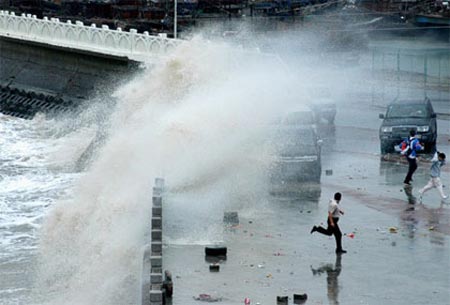Large storms can cause earthquakes
Large storms always reduce the pressure on the ground. In areas with unstable geological structures, pressure depressions cause cracks in the ground to become wider and lead to slow earthquakes.

A big storm in China.Photo: gearfuse.com.
Dr. Alan Linde, a geologist of the Carnegie Institute of Science (USA) and his colleagues tracked the movement of two stratigraphic plates in eastern Taiwan with stretch gauges buried deep underground. These devices are capable of detecting movements that people do not feel beneath the ground. In addition, they can monitor the deformation of the rock due to the collision between tectonic plates.
The team found 20 slow earthquakes - meaning they lasted a few hours to more than a day. Among them were 11 seismic events that occurred at the same time as the big storm. The team confirmed that the coincidence was not random, but followed a rule.
'It is very rare for us to see the time coincidence between earthquakes and storms with such great probability,' said Dr. Linde. According to him, plate tectonic plates move so quickly that they can create mountains with speeds of approximately 4 mm per year.
'For the geologists, the speed is equivalent to growing mushrooms for a few days , ' Linde said.
However, there are very few strong earthquakes in this area and only a few strong earthquakes. Two stratigraphic plates in the Nankai depression in southwestern Japan also collide and form a mountain at a rate of 4 mm per year. But every year between 100 and 150 years the region suffers from an earthquake of magnitude 8 or more. That situation does not happen in Taiwan.
'In fact, two stratigraphic plates in eastern Taiwan are two layers in the Namkai concave region of Japan. Yet the number of large earthquakes in the two regions is completely different, ' Linde said.
Linde said that when a large storm travels through land, it will reduce air pressure on the ground. Although the level of pressure change is relatively small, it is still capable of widening geological cracks and causing tectonic plates to shift. If a crack is wide enough, the presence of a storm will cause it to cause an earthquake. However, these geologic episodes occur so slowly that humans can hardly feel it. Even the team argues that they reduce the number of occurrences and magnitudes of large earthquakes.
- Solar storms are impervious to earthquakes
- Storms can cause earthquakes
- Recreate earthquakes in laboratories
- Storm-earthquake: A new disaster awaits humans
- Video: Fire storms make people impassive
- This afternoon storms into the waters of Binh Dinh - Phu Yen provinces
- Video: Large dust storms attack the United States
- Unknown things about earthquakes
- Ocean storms can cause earthquakes
- Earthquakes caused many local shakes in Thua Thien Hue
- Hydropower stimulates artificial earthquakes
- Found a way to detect large earthquakes early by ... gravity waves
 Is the magnetic North Pole shift dangerous to humanity?
Is the magnetic North Pole shift dangerous to humanity? Washington legalizes the recycling of human bodies into fertilizer
Washington legalizes the recycling of human bodies into fertilizer Lightning stone - the mysterious guest
Lightning stone - the mysterious guest Stunned by the mysterious sunset, strange appearance
Stunned by the mysterious sunset, strange appearance